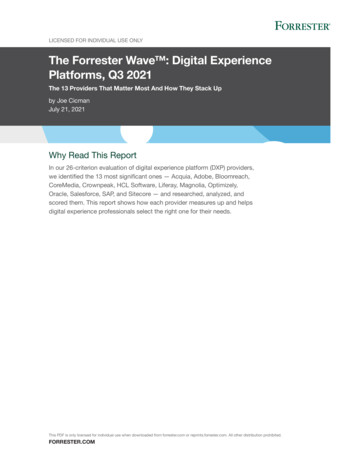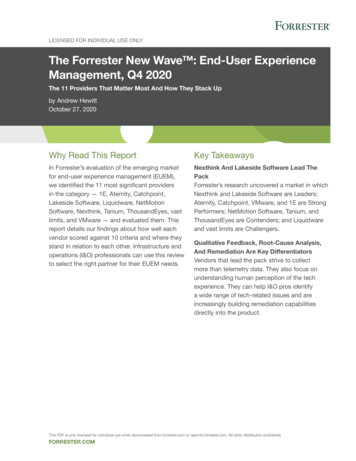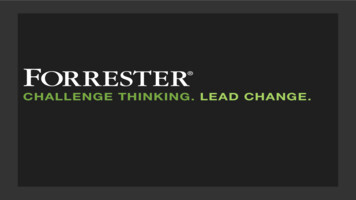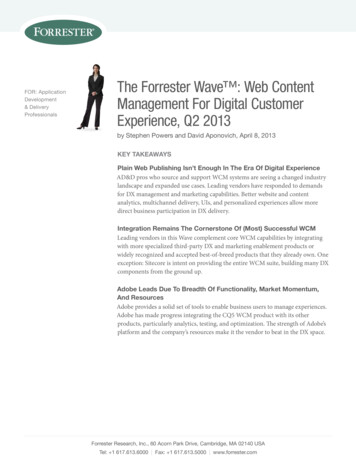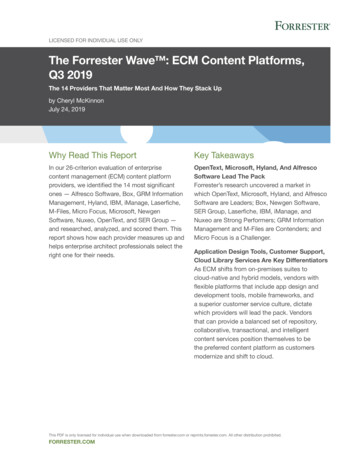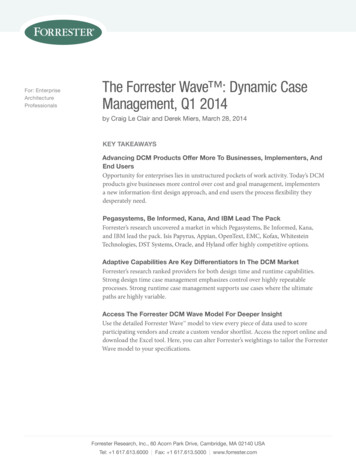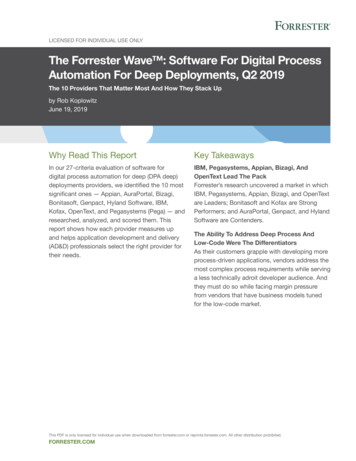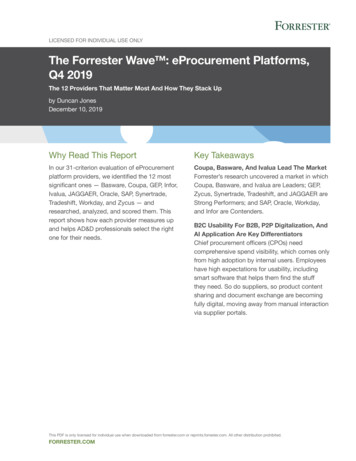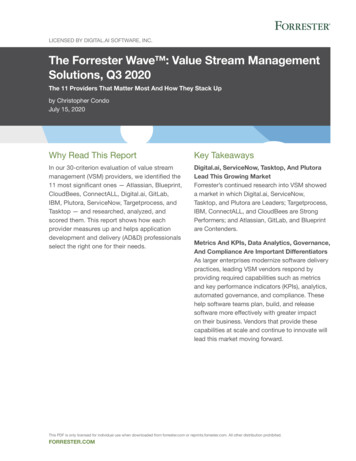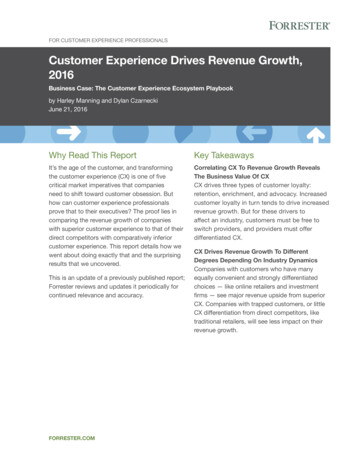
Transcription
For Customer Experience ProfessionalsCustomer Experience Drives Revenue Growth,2016Business Case: The Customer Experience Ecosystem Playbookby Harley Manning and Dylan CzarneckiJune 21, 2016Why Read This ReportKey TakeawaysIt’s the age of the customer, and transformingthe customer experience (CX) is one of fivecritical market imperatives that companiesneed to shift toward customer obsession. Buthow can customer experience professionalsprove that to their executives? The proof lies incomparing the revenue growth of companieswith superior customer experience to that of theirdirect competitors with comparatively inferiorcustomer experience. This report details how wewent about doing exactly that and the surprisingresults that we uncovered.Correlating CX To Revenue Growth RevealsThe Business Value Of CXCX drives three types of customer loyalty:retention, enrichment, and advocacy. Increasedcustomer loyalty in turn tends to drive increasedrevenue growth. But for these drivers toaffect an industry, customers must be free toswitch providers, and providers must offerdifferentiated CX.This is an update of a previously published report;Forrester reviews and updates it periodically forcontinued relevance and accuracy.forrester.comCX Drives Revenue Growth To DifferentDegrees Depending On Industry DynamicsCompanies with customers who have manyequally convenient and strongly differentiatedchoices — like online retailers and investmentfirms — see major revenue upside from superiorCX. Companies with trapped customers, or littleCX differentiation from direct competitors, liketraditional retailers, will see less impact on theirrevenue growth.
For Customer Experience ProfessionalsCustomer Experience Drives Revenue Growth, 2016Business Case: The Customer Experience Ecosystem Playbookby Harley Manning and Dylan Czarneckiwith Alyson Clarke, Kate McCarthy, Christopher Mines, Sucharita Mulpuru, James Nail, Scott Ross,and Kara HartigJune 21, 2016Table Of Contents2 Does Superior Customer Experience PayOff?2 Better CX Correlates With Higher RevenueGrowth In Most IndustriesCable: AT&T U-Verse Beats Comcast XfinityAirlines: CX Leader Southwest OutgrewUnitedInvestment Firms: Leaders Edward Jones AndCharles Schwab Beat LaggardsRetailers: Superior Online ExperienceTrounces The Traditional Retail Experience7 The CX/Revenue Growth EquationNotes & ResourcesWe used Forrester’s Customer Experience Index,US Consumers Q3 2015, which we complementedwith third-party customer satisfaction scores,to identify direct competitors with significantdifferences in the quality of their customerexperience. We then analyzed their US Securitiesand Exchange Commission (SEC) filings to buildmodels that compared their revenue growth.Related Research DocumentsCustomer Advocacy 2014: How US ConsumersRate Their Financial InstitutionsThe US Customer Experience Index, Q3 2015How The CX/Revenue Growth EquationExplains The Dynamics Of Each Industry9 Craft Your Customer Experience StrategyFor GrowthWhat It Means10 CX Leaders And Laggards Will Continue ToGo Their Separate Ways12 Supplemental MaterialForrester Research, Inc., 60 Acorn Park Drive, Cambridge, MA 02140 USA 1 617-613-6000 Fax: 1 617-613-5000 forrester.com 2016 Forrester Research, Inc. Opinions reflect judgment at the time and are subject to change. Forrester ,Technographics , Forrester Wave, RoleView, TechRadar, and Total Economic Impact are trademarks of ForresterResearch, Inc. All other trademarks are the property of their respective companies. Unauthorized copying ordistributing is a violation of copyright law. Citations@forrester.com or 1 866-367-7378
For Customer Experience ProfessionalsJune 21, 2016Customer Experience Drives Revenue Growth, 2016Business Case: The Customer Experience Ecosystem PlaybookDoes Superior Customer Experience Pay Off?In 2015, we explored whether customer experience really matters to business success or whether CXis just the latest hype. We found that superior CX drives superior revenue growth in industries wherecustomers are free to switch business and competitors deliver a differentiated customer experience.1Does this finding still hold true? To find out for CX professionals, we:›› Identified direct competitors with significant differences in CX quality. We selected pairs ofpublicly traded companies that compete directly for the same types of customers, where one of thecompetitors was an industry leader in Forrester’s Customer Experience Index (CX Index ) and theother lagged behind during the period of 2010 to 2015.2›› Built models that compared the growth of leaders and laggards over time. Using financialdata that we culled from annual reports and SEC filings like Forms 10-K and 10-Q, we isolated therevenue streams for specific lines of business within large corporations and calculated the compoundannual growth rate (CAGR) of their revenue from 2010 to 2015. This allowed us to compare directcompetitors and determine whether or not customer experience actually correlates with growth.Better CX Correlates With Higher Revenue Growth In Most IndustriesIn all, we examined five industries with diverse competitive dynamics and revenue models. The onlynotable thing that these industries have in common is that the end user of their products or services isa consumer.Cable: AT&T U-Verse Beats Comcast XfinityAT&T U-verse scored near the top of Forrester’s CX Index rankings for internet service providers (ISPs)in Q3 2015. And although U-verse was just average as a TV service provider, it was still significantlyahead of Comcast, which was the lowest-scoring brand in both industries.3 ACSI scores confirmedthese relative rankings. AT&T came in first as an ISP and second as a subscription TV service provider,while Comcast was last as an ISP and second to last as a subscription TV service provider.Analyzing their performance was a challenge. The financials of U-verse are buried in the annual reportof AT&T: a massive corporation that also includes a giant wireless business. Similarly, Comcast’s cableoperation is just one of five business segments in Comcast’s annual reports. Nonetheless, we teasedout the revenue and subscriber numbers for both corporations’ cable offerings (ISP plus video).4 Whenwe compared them with each other, we found that from 2010 to 2015 (see Figure 1):›› AT&T clearly showed superior revenue growth. There was a stark contrast between the revenuegrowth rates of our leader and our laggard. AT&T had a revenue CAGR of more than 29%. Duringthat same period, Comcast’s revenue grew less than 5%. 2016 Forrester Research, Inc. Unauthorized copying or distributing is a violation of copyright law.Citations@forrester.com or 1 866-367-73782
For Customer Experience ProfessionalsJune 21, 2016Customer Experience Drives Revenue Growth, 2016Business Case: The Customer Experience Ecosystem Playbook›› AT&T continues to crush Comcast in subscriber growth. To understand the reason behindthis difference in revenue growth, we examined the customer growth of both providers. AT&T haddouble-digit growth among both its internet and video service subscribers. Comcast had singledigit growth among its internet subscribers and negative growth among its video subscribers.5FIGURE 1 Revenue Growth Rates For Two Competitors In The Cable IndustryCompound annual growth rates, 2010 to 2015CX leader: AT&TCX laggard: subscribersVideosubscribersSource: US Securities and Exchange Commission filings by AT&T and ComcastAirlines: CX Leader Southwest Outgrew UnitedIn 2016, we replaced JetBlue Airways in our analysis with perennial customer favorite SouthwestAirlines. That’s because the size of Southwest, which is the largest US domestic air carrier, is muchcloser to fellow behemoth — and CX laggard — United Airlines. Southwest has consistently scored ator near the top of our CX Index rankings, and in the 2016 ACSI rankings, it tied with JetBlue for first.6 Incontrast, United was last among major airlines in both our CX Index and the ACSI. We backed out theeffects of United’s merger with Continental in 2010, so unlike the 2015 analysis, our comparison nowspans a full five years. We found that (see Figure 2):›› Southwest’s revenue grew more than three times faster than United’s revenue. Over thisfive-year period, Southwest turned in a strong revenue CAGR of 7.3%. In contrast, United onlymanaged to grow its revenues by 2.2%. Because Southwest has a much smaller internationalbusiness than United, we also calculated their revenue CAGR for US domestic flights only. Whenwe did, we found that Southwest’s revenue CAGR decreased slightly to 6.9% and United’s revenueCAGR shrank to -0.3%.7 2016 Forrester Research, Inc. Unauthorized copying or distributing is a violation of copyright law.Citations@forrester.com or 1 866-367-73783
For Customer Experience ProfessionalsJune 21, 2016Customer Experience Drives Revenue Growth, 2016Business Case: The Customer Experience Ecosystem Playbook›› Southwest also outgrew United on revenue passenger miles. During the 2010-to-2015 timeperiod, Southwest’s revenue passenger miles (i.e., a paying passenger flying one mile) grew by4.8% while United’s revenue passenger miles shrank by -1.5%. This shows that Southwest flewpaying customers more miles, while United flew paying customers fewer miles.FIGURE 2 Revenue Growth Rates For Two Competitors In The Airline IndustryCompound annual growth rates, 2010 to 2015CX leader: Southwest AirlinesCX laggard: United Airlines7.3%6.9%4.8%2.2%-1.5%-0.3%Domestic revenueGlobal revenueRevenue passenger milesSource: US Securities and Exchange Commission filings by Southwest Airlines and United ContinentalHoldingsInvestment Firms: Leaders Edward Jones And Charles Schwab Beat LaggardsNot all investment firms compete for the same types of customers. So we compared two competitors inthe full-service investments category — CX leader Edward Jones versus comparative CX laggard MorganStanley Wealth Management — as well as two competitors in the direct investments category — CXleader Charles Schwab and its CX laggard rival E-Trade (see Figure 3).8 When we compared their revenuethat came from consumer-facing businesses, we found that:›› Edward Jones grew almost twice as fast as Morgan Stanley Wealth Management. EdwardJones has a highly differentiated strategy that emphasizes personal relationships betweencustomers and their local financial advisors. The firm has risen steadily in our CX Index rankings; inQ3 2015, it tied for eighth place overall across all industries. It is also a top performer in Forrester’scustomer advocacy rankings and highly rated in J.D. Power’s industry rankings for 2016.9 Thisstrong across-the-board showing carries through to Jones’ five-year revenue CAGR of 10%, whicheasily beats the 3.8% revenue CAGR of Morgan Stanley during the same period. 2016 Forrester Research, Inc. Unauthorized copying or distributing is a violation of copyright law.Citations@forrester.com or 1 866-367-73784
For Customer Experience ProfessionalsJune 21, 2016Customer Experience Drives Revenue Growth, 2016Business Case: The Customer Experience Ecosystem Playbook›› Charles Schwab grew at a double-digit rate, while E-Trade barely grew. Schwab puts a strongemphasis on running its business “through client’s eyes,” which is a focus that led it to be anearly industry adopter of customer ratings and reviews.10 In 2015, the firm was also ahead of itscompetitor E-Trade in Forrester’s CX Index and customer advocacy rankings as well as in J.D.Power’s overall satisfaction rankings. In our analysis, we found that Schwab’s five-year revenueCAGR was 10.7% — far outstripping the 1.6% that we calculated for E-Trade.FIGURE 3 Revenue Growth Rates For Competitors In The Investments IndustryRevenue growth rates for two competitors in the full-service investments industryCompound annual growth rates, 2010 to 2015CX leader: Edward JonesCX laggard: Morgan Stanley Wealth Management10.0%3.8%RevenueSource: US Securities and Exchange Commission filings by Edward Jones and Morgan StanleyRevenue growth rates for two competitors in the direct investments industryCompound annual growth rates, 2010 to 2015CX leader: Charles SchwabCX laggard: E-Trade10.7%1.6%RevenueSource: US Securities and Exchange Commission filings by Charles Schwab and E-Trade 2016 Forrester Research, Inc. Unauthorized copying or distributing is a violation of copyright law.Citations@forrester.com or 1 866-367-73785
For Customer Experience ProfessionalsJune 21, 2016Customer Experience Drives Revenue Growth, 2016Business Case: The Customer Experience Ecosystem PlaybookRetailers: Superior Online Experience Trounces The Traditional Retail ExperienceIn retail, most direct competitors have undifferentiated customer experiences. For example, Costco andSam’s Club have CX Index scores that are virtually identical. The same is true for JCPenney and Macy’s,Home Depot and Lowe’s, as well as many other large retailers that go head to head.11 This CX parity stoppedus from making the direct comparisons between CX leaders and CX laggards that we did in other industries.However, when we separated online-only retailers from traditional retailers (i.e., bricks and clicks) in ourCX Index, we saw some glaring differences. Online-only retailers like Amazon, eBay, and Etsy placed farahead of traditional retailers: Their industry average score was the same as the highest score among thetraditional retailers. As proxies for online CX versus offline CX, we therefore compared the largest highscoring online retailer, Amazon, with the largest low-scoring traditional retailer, Walmart.12 We found that:›› Online-only CX leader Amazon left Walmart’s overall revenue growth in the dust. Amazon’sfive-year US revenue CAGR of 27.7% was almost 14 times Walmart’s US revenue CAGR of 2.1%(see Figure 4).13 The fact that online beats traditional is not surprising: Online retailing benefits fromthe rapid growth of the internet, including mobile.14 The magnitude of the difference is, however,notable given that Amazon grew off of a very large base during this period and more than tripled itsUS net sales from 18.7 billion to 63.7 billion.›› Walmart’s online revenue trumped its own overall revenue performance. Forrester’s CustomerExperience Index, US Consumers Q3 2015, found that customers who said that their most recentinteraction with Walmart was via its website scored the retailer eight points higher than customerswho said that their most recent interaction with Walmart was through any other touchpoint. Thisrepresents another vote for the superiority of online CX. The results of this enhanced experienceare reflected in Walmart’s global online revenue CAGR from 2010 to 2015, which grew 27.3%.During the same period, same-store sales for brick-and-mortar stores remained essentially flat.FIGURE 4 Revenue Growth Rates For Two Competitors In The Retail IndustryCompound annual growth rates, 2010 to 2015CX leader: AmazonCX laggard: Walmart27.7%2.1%RevenueSource: US Securities and Exchange Commission filings by Amazon and Walmart 2016 Forrester Research, Inc. Unauthorized copying or distributing is a violation of copyright law.Citations@forrester.com or 1 866-367-73786
For Customer Experience ProfessionalsJune 21, 2016Customer Experience Drives Revenue Growth, 2016Business Case: The Customer Experience Ecosystem PlaybookThe CX/Revenue Growth EquationWhy doesn’t customer experience always correlate with revenue growth? And why does the differencein revenue growth differ so much by industry? To answer these questions, starting with what we knowis helpful: Good customer experience drives customer loyalty.15 In other words, companies that delivera better customer experience tend to retain more of their customers, get more incremental purchasesfrom their customers, and attract more new customers through positive word of mouth. Whether thatincreased loyalty in turn drives revenue growth depends on two interrelated variables (see Figure 5):›› Customers’ freedom of choice. It’s not always possible or practical for customers to switchproviders. Factors ranging from geography (like a town with one cable provider) to contractualobligation (employer-sponsored health plans) can leave consumers with just one choice: Take itor leave it. In these cases, it doesn’t matter whether unsatisfied customers want to abandon theircurrent relationship — they’re trapped. At the other end of the spectrum, online customers whoshop or make personal investments have near-infinite freedom to switch retailers or investmentfirms quickly and easily.›› Competitors’ CX differentiation. The essence of competitive strategy is positioning — takingand holding a place that’s different from competitors in the minds of customers. When customersdon’t see a meaningful difference in the customer experience that competitors provide — such aswith traditional retailers in most categories — they have no motivation to switch that’s based purelyon CX. But when companies offer significantly differentiated customer experience, as we see inthe airline, investment, and online-only retail industries, poor CX provides a powerful incentive todefect, and superior CX provides a compelling reason to stay.FreeFIGURE 5 The CX/Revenue Growth EquationCX drives revenue — lots of it Customers can easily switchbusiness among many companies.Customers CX leaders stand out from peers.TrappedCX doesn’t drive revenue Customers have one choice:Take it or leave it. Competitors’ CX wouldn’t lureaway customers even if theycould switch.At parityCompetitors’ CXDifferentiated 2016 Forrester Research, Inc. Unauthorized copying or distributing is a violation of copyright law.Citations@forrester.com or 1 866-367-73787
For Customer Experience ProfessionalsJune 21, 2016Customer Experience Drives Revenue Growth, 2016Business Case: The Customer Experience Ecosystem PlaybookHow The CX/Revenue Growth Equation Explains The Dynamics Of Each IndustryWhen we use our equation to map the industries that we analyzed onto a grid, their relative potentialfor CX-fueled revenue growth becomes clear (see Figure 6).›› Cable companies see substantial revenue upside on a market-by-market basis. Cablecustomers can only choose among providers that lay down pipes in their town. If there’s just oneprovider in a town — the original cable franchise — customers are trapped, and the cable operatoris less motivated to provide good customer experience.16 But as soon as AT&T or Verizon lays asecond cable in a town, customers have another option — and that option has significantly betterCX quality. AT&T and Verizon don’t even need to be great to win business. They just need to begood enough to steal away customers from their competitors. And that’s exactly what they’redoing. Customers don’t defect just because they can; they leave because they expect to get abetter experience, and then they stay because they do get a better experience.›› Airlines, like cable companies, drive revenue growth market by market. Airline customers canonly fly carriers that have gates at their local airport. Even then, not all of the carriers offer directflights or flights with times that can work given other constraints of a trip. What’s more, some of themost profitable fliers have voluntarily trapped themselves by accumulating frequent-flier miles inloyalty programs. These factors put an artificial limit on the amount of revenue growth that airlinescan drive with superior CX. However, such noticeable differences between CX leaders like JetBlue,Southwest, and Virgin America and laggards like United and American Airlines mean that thereremains strong potential for revenue growth in the markets where they do compete.›› Investment firms have vast potential for CX-fueled revenue growth. Investment firms servecustomers who can leave them with relatively low effort, compared with either cable companies orairlines — especially if those customers opt to manage their investments online. For this industry,CX-fueled customer loyalty can be extremely powerful in driving revenue growth. Switchingaccounts from one full-service firm to another requires some effort. That means there’s probablymore upside in improved customer retention and incremental purchases than there is in newcustomer acquisition for full-service firms like Edward Jones. But for a firm like Schwab, thepotential to win customers from competitors through superior CX is substantial.›› Traditional retailers face significant threats from online alternatives. Shoppers in most marketshave many brick-and-mortar options within reach but little reason to make the trip to one that’sless convenient — at least not because of customer experience that’s at parity for most traditionalretailers. They will therefore choose retailers by other factors, like selection, price, or location. Butonline is a game changer that dramatically expands freedom of choice — and those choices offercustomers significantly better experiences. That’s one reason why Forrester expects online retailingto grow at the expense of traditional retailers, for which sticking to the same old, same old meansslow death.17 2016 Forrester Research, Inc. Unauthorized copying or distributing is a violation of copyright law.Citations@forrester.com or 1 866-367-73788
For Customer Experience ProfessionalsJune 21, 2016Customer Experience Drives Revenue Growth, 2016Business Case: The Customer Experience Ecosystem PlaybookFreeFIGURE 6 The CX/Revenue Growth Equation Explains The Dynamics Of Each rsAt parityCompetitors’ CXDifferentiatedCraft Your Customer Experience Strategy For GrowthDoes customer experience really drive business success? Yes, for the five industries that we examined, itdoes. Customer experience professionals looking to drive revenue growth — or simply avoid revenue loss— should take the following steps.›› Step 1: Map yourself and your competitors on our CX/revenue growth grid. How freely canyour customers move from provider to provider? Do you face strongly differentiated CX leadersand CX laggards, or are you and your direct competitors at or near parity? The answers to thesequestions will help you determine where your company’s positioned now and whether there’s anopening for you, a current competitor, or a new disruptor to gain a competitive advantage becauseof superior customer experience.›› Step 2: Assess your potential. If there is a CX-fueled opportunity in your industry, can yourcompany seize it? Or will you have to settle for defending your company against some other firmthat can? In all likelihood, the answer for your company will depend on two things: how muchbusiness discipline it brings to the practice of CX today and whether it can produce differentiatingCX innovations in the future. To gauge your current level of CX discipline, score yourself usingForrester’s CX maturity framework.18 And to determine your innovation readiness, ask yourself howwell your company can enable experimentation, reframe customer problems, and rally the troopsacross your organization. If design thinking sounds fanciful, or if your executives won’t engage withpotentially scary ideas, then sorry, but your company doesn’t have what it takes to distance itselfenough from competitors to make a difference.19 2016 Forrester Research, Inc. Unauthorized copying or distributing is a violation of copyright law.Citations@forrester.com or 1 866-367-73789
For Customer Experience ProfessionalsJune 21, 2016Customer Experience Drives Revenue Growth, 2016Business Case: The Customer Experience Ecosystem Playbook›› Step 3: Craft your CX strategy. Now, identify your business objectives and opportunities. Is revenuegrowth your primary goal, and if so, is it possible for your company in your industry to achievethat goal? Companies that fall in the upper-left section of our grid and can answer “yes” to thesequestions should try to break from the pack of “me too” competitors, as Home Depot has set outto do. Companies in the upper-right section can dominate their competitors by obsessively servingthe CX needs of a desirable customer segment better than competitors, as Edward Jones has beendoing. And even companies in the lower-left part of the grid can invest wisely in CX by crafting astrategy that instills CX discipline to manage service costs while readying their firms for acceleratedefforts when disruption eventually ramps up — as it did in the cable industry (see Figure 7).FreeFIGURE 7 Example CX Strategies That Are Rooted In The CX/Revenue EquationDominatea segmentCustomersBreak fromthe packTrappedRide thedisruptionAt parityDifferentiatedCompetitors’ CXWhat It MeansCX Leaders And Laggards Will Continue To Go Their Separate WaysJust because a company has ignored customer experience to date doesn’t mean that the companyhas been poorly run; that might be the case, but it doesn’t follow inevitably from our findings.However, knowing why companies haven’t focused on CX in the past and how they managed tosucceed anyway — combined with an understanding of their current competitive environment —helps CX professionals clarify where their firms are heading in the future.1. Cable: CX laggards will play catch-up with accelerating CX leaders. Legacy cable operatorsignored CX because investing in it didn’t make as much economic sense as other things thatthey could do with their money — like acquiring rivals. Now, facing aggressive competition, 2016 Forrester Research, Inc. Unauthorized copying or distributing is a violation of copyright law.Citations@forrester.com or 1 866-367-737810
For Customer Experience ProfessionalsJune 21, 2016Customer Experience Drives Revenue Growth, 2016Business Case: The Customer Experience Ecosystem Playbookthey’ve begun to improve customer experience, mostly by fixing problems in an attempt toeliminate frustration from customer interactions. Meanwhile, AT&T and Verizon continue to investin CX improvements while making strategic acquisitions that give them enhanced capabilitiesand more subscribers.20 This will push the industry further up and to the right of the CX/revenuegrowth grid as fiber gets laid down in more communities. And as the pay-TV service industrydeclines, the battle over internet subscribers will intensify, with legacy providers focusing onfaster broadband and enhanced capabilities. This is where AT&T and Verizon’s position asmultiple-platform content providers will become pivotal in creating differentiated experiences thatintegrate video, broadband, and wireless services.2. Airlines: CX leaders will look to increase their advantage. The recent massive drop in oil pricesgave airlines the opportunity to either lower prices in an attempt to win customers or improvetheir typically low operating margins. They universally chose the latter path. That’s symptomatic ofan industry that’s trying to get on firmer financial footing after it historically pursued growth overprofits. However, JetBlue and Southwest will invest to maintain and even increase their leadershippositions, with an outside chance of unveiling disruptive CX innovations.21 United and Americanwill continue to treat CX as one tactic among many — like charging new fees or squeezing inmore seats — for improving margins. However, neither one shows signs of making a seriouscommitment to CX as a strategy. The wild card in this game is Delta Air Lines. Its impressivecommitment to becoming the “no cancellations” airline has manifested a range of strategicinitiatives that could move it into JetBlue and Southwest territory.223. Investment firms: CX leaders will engage in an arms race of innovation. Even a typicalinvestment firm offers online features like comparisons, ratings, reviews, and immersive interactivetools that are competitive with those of the best digital-only retailers. What’s more, firms withhighly rated CX, like Schwab and Vanguard, are rolling out innovative digital and omnichannelproducts to one-up would-be disruptors like Betterment and Wealthfront.23 Expect the wave ofinnovations that have a basis in deep customer understanding and sophisticated user-centereddesign to accelerate, especially from USAA. It more than makes up for its relative lack of sizethrough a combination of the most customer-centric culture in the business plus increasinglysophisticated CX innovation. An example is the Savings Coach app that it developed with voicerecognition and text-to-speech technology provider Nuance Communications.24 The result: Firmsthat don’t constantly improve their CX will see their customers stolen by those that do.4. Retailers: Some firms will play to win and others, not to lose. Factors like selection andconvenience give online sellers an inherent CX advantage. Some traditional retailers will seekto offset these advantages by bringing the benefits of online — including responsiveness andimmersive multimedia content — to their physical spaces, as Burberry has been doing. Otherswill try to counterbalance the web’s shop-anytime ease with efforts to extend physical storehours; some will go so far as to operate stores 24x7 with the aid of remote monitoring, moreself-service, and skeletal staffs.25 Smart players will also shift the culture of their store associatestoward customer centricity by paying fewer associates more money to attract higher-quality 2016 Forrester Research, Inc. Unauthorized copying or distributing is a violation of copyright law.Citations@forrester.com or 1 866-367-737811
For Customer Experience ProfessionalsJune 21, 2016Customer Experience Drives Revenue Growth, 2016Business Case: The Customer Experience Ecosystem Playbookpeople who can deliver a better customer experience — as Trader Joe’s and The ContainerStore do today. Ultimately, though, the real CX/revenue growth winners will be sellers withstrongly differentiated conc
the us Customer experience index, Q3 2015 For CustoMer experienCe proFessionals Customer Experience Drives Revenue Growth, 2016 . competitors was an industry leader in Forrester's Customer experience index (Cx index ) and the other lagged behind during the period of 2010 to 2015.2


